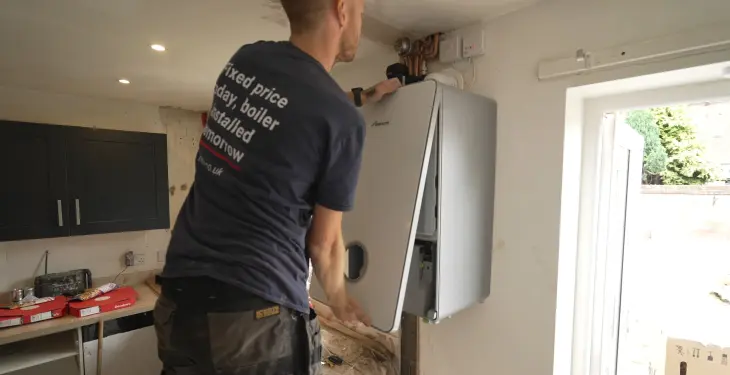

Written by Stephen Day
Gas Safe Engineer
Updated: 30th May, 2025
If you own an older boiler, you might be familiar with the pilot light. The pilot light is an essential part of the boiler system flame that is responsible for igniting the gas that is provided to the boiler, allowing it to heat up your home and deliver warm water to your taps.
Normally, the pilot light will constantly burn, however, there are rare occasions when your pilot light might go out. In this guide, we’ll be taking a look at some of the reasons why your pilot light might be going out, how to relight it and what to do if the problem persists.
Get a quote in 60 seconds, fitted as fast as next day!
0% APR finance available.
Get a free fixed price quote for a new boiler installed fast!
Firstly, you should try to find the instruction manual for your specific boiler and look for the section on relighting your pilot light, however, we understand that boiler manuals often get thrown into the ‘everything drawer’ and are never seen again, which is why we’ve got some instructions below that generally work for most boilers.
To begin with, you’ll need to identify whether your boiler has a manual pilot light or an automatic one.
Manual pilot lights: You can tell if your pilot light is manual by taking a look at the gas control knob. If there are three settings labelled ‘off’, ‘on’ and ‘pilot’, it’s likely that you have a manual pilot light.
Automatic pilot lights: If you have an automatic pilot light there will usually be a safety label fixed to the front of your boiler that tells you it has an automatic ignition system. If you can’t spot a label, find the gas control knob and look at its settings. If there are just two settings- ‘off’ and ‘on’, you will likely have an automatic pilot light. It’s important to note that you shouldn’t attempt to light automatic pilot lights manually.
If your boiler has a manual pilot light, follow the instructions below:
Ensure your gas control knob is turned to 'off’ and not ‘on’ or ‘pilot’ to prevent any build up of flammable gases and reduce the risk of dangerous incidents. If the pilot lights on any other appliances are also out make sure to turn them off too.
Turn down the thermostat or, smart thermostat, to the lowest setting.
Wait for roughly 10-15 minutes to allow any gas fumes to dissipate from the boiler.
Once you’re sure the gas has safely dissipated, remove the boiler cover/panel.
Turn the gas control knob to ‘pilot’ and hold down the knob to release gas into the boiler’s pilot light hole.
Whilst still holding down the knob, light a long match or lighter and hold it at the tip of the pilot. Once lit, blow out the match carefully to ensure you don’t blow out the pilot light too.
Keep the gas control knob held down for a further minute until the flame starts turning blue.
Once you have released the knob, the pilot light will usually continue to burn, however, if it goes out again, the re-ignition hasn’t worked and you should repeat the steps.
If your pilot light is still failing to stay lit after two attempts, turn the gas control knob back to off and contact a Gas Safe registered engineer to take a look. A boiler with a faulty pilot light can be very dangerous as the boiler may continue to release gas into your home when the flame is extinguished, putting you at risk of carbon monoxide poisoning.
If your boiler has an automatic pilot light, follow the instructions below:
Turn off your boiler at its electrical switch. This can usually be found on the boiler itself or you may have to find the breaker panel in order to flip the breaker switch to ‘off’.
Remove the boiler cover/panel.
Ensure your gas control knob is turned to ‘off’.
Wait for roughly 10-15 minutes to allow any gas fumes to dissipate from the boiler.
Turn the gas control knob back to ‘on’.
Flip the electrical switch or breaker back to ‘on’. This should result in a clicking sound as the automatic starter ignites the pilot light, however, if your pilot doesn’t reignite after 30 seconds or if the clicking sound doesn’t stop, be sure to turn off the boiler and the gas control knob and call a Gas Safe registered engineer to take a look. A boiler with a faulty pilot light can be very dangerous as the boiler may continue to release gas into your home when the flame is extinguished, putting you at risk of carbon monoxide poisoning.
Get a free fixed price quote for a new boiler installed fast!
There are a number of things that can cause your boiler pilot light to keep going out. Below is a list of the most common reasons:
The thermocouple aka the ‘flame sensor’ is a copper rod that is directly hit by the pilot flame and is a safety mechanism that turns off the gas if it detects the pilot light has gone out protecting you from a buildup of harmful gas in your home. However, if your thermocouple is broken, dirty or misaligned, it may malfunction, shutting off the gas valve and preventing your pilot light from staying lit.
If you suspect your thermocouple is at fault, we’d recommend calling out a Gas Safe registered engineer to come and take a look. When dealing with gas appliances it’s best to leave it to the professionals to avoid making any mistakes that could lead to further damage or carbon monoxide poisoning, which can be fatal.
If you’re able to ignite your pilot light for a few seconds, try to take a look at the flame. When working correctly, the flame should be a strong blue cone. If you notice that the flame is weak and yellow, it can mean that the pilot orifice has got a buildup of dirt, preventing the flame from enveloping the thermocouple properly and therefore shutting off the gas.
If you suspect a dirty pilot orifice is at fault we’d recommend calling out a Gas Safe registered engineer to come and take a look. When dealing with gas appliances it’s best to leave it to the professionals to avoid making any mistakes that could lead to further damage or carbon monoxide poisoning, which can be fatal.
This is especially true if the pilot flame is yellow as this can be a strong indicator of a carbon monoxide gas leak and must be seen immediately. Important: If you think you have a gas leak or can smell gas, leave the house and phone the National Gas Emergencies number immediately on 0800 111 999.
The regulator in your natural gas meter outside your home impacts every gas appliance in your home. If you have a poorly working gas regulator, your boiler may not be receiving enough gas to keep the pilot light lit. If you spot pilot problems in a number of other household appliances, it’s likely that the gas regulator is the culprit. In this case, you should contact your utility company straight away.
If you can easily relight your pilot light but find it suddenly goes out on particularly windy days, you may have a strong draught that is blowing your pilot light out. If you suspect a draught may be blowing out your pilot light, you’ll need a Gas Safe Engineer to come out and take a look at your boiler as draughts shouldn’t be able to affect your pilot light.
Get a quote in 60 seconds, fitted as fast as next day!
0% APR finance available.
At iHeat, we install high quality, A-rated efficient boilers at an affordable price. Whilst you might think that it isn’t worth getting a new boiler over a few issues such as a broken thermocouple or a boiler that lets strong draughts in, purchasing a new boiler could actually save you money in the long run. Not only can a new boiler save you money on expensive repairs and callout bills, but The Energy Saving Trust estimates that you could save up to £380 a year by replacing your old inefficient boiler with a new A-rated one. Get a quote on a new A-rated boiler today.
iHeat accepts no accountability for any injuries or damages you sustain following the advice in this article. If in doubt, seek professional assistance from a Gas Safe registered engineer.
Last updated: 30th May, 2025

Written by Stephen Day
Gas Safe Engineer at iHeat
Stephen Day is a Gas Safe registered and FGAS certified engineer with over 20 years of hands-on experience in the heating, cooling, and renewable energy industry, specialising in boiler installations, air conditioning, and heat pump systems.
LinkedInArticles by Stephen Day are reviewed by iHeat’s technical team to ensure accuracy and reliability.

22nd December, 2025
Based on data from over 7000 boiler installations completed by iHeat in the past 12 months...
 Read Article
Read Article

22nd December, 2025
Here’s a quick roundup of the best combi boilers for 2026.
 Read Article
Read Article

22nd December, 2025
When your old boiler breaks down and it comes time to replace it with a new one, it might...
 Read Article
Read Article
No obligation. Takes less than 60 seconds.